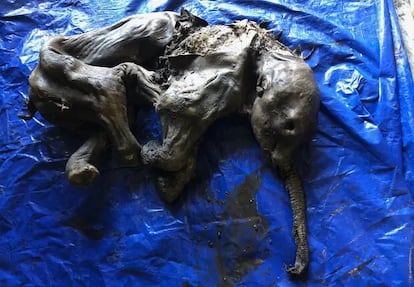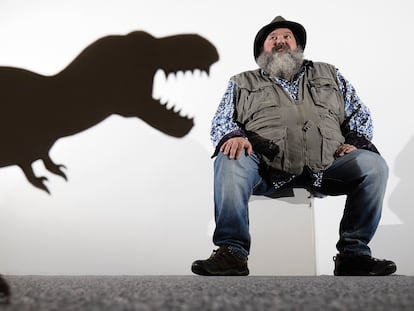Mummified baby woolly mammoth found in northern Canada
The specimen located in the Yukon is over 30,000 years old, according to experts


The Yukon is known as a land of adventures and mysteries. Last Tuesday, in the Canadian territory, an exceptionally well preserved baby woolly mammoth was found by a gold miner. “[She] is beautiful and one of the most incredible mummified ice age animals ever discovered in the world,” paleontologist Grant Zazula said in a government statement issued last Friday. The remains were found under permafrost in a gold mine south of Dawson City, on the Canadian border with Alaska.
It is the first such discovery in North America and the second in the world, after a similar specimen was found in Siberia in 2007. The calf is a female measuring 140 cm in length. Experts believe she was between 30 and 35 days old at the time of death. They also calculate that the body has been preserved for over 30,000 years. Wooly mammoths became extinct about 4,000 years ago.
A mine worker who was carrying out excavation tasks found the animal’s remains. His supervisors contacted the authorities of the Yukon and of Trʼondëk Hwëchʼin, the indigenous community where this gold mine is located, and a team of geologists and paleontologists traveled to the area to take over the work.
Speaking to the Canadian public broadcaster CBC, Grant Zazula said that experts found a piece of the animal’s intestine covered in grass. “That’s telling us what she did the last moments of her life,” he said. Zazula and the other researchers believe the mammoth was probably a few steps from its mother, but ventured out to eat grass and drink water and got stuck in the mud. “That event, from getting trapped in the mud to burial was very, very quick,” he added.
The mammoth has been given the name Nun cho ga, which means “big baby animal” in the local language. “We’re all quite excited including the elders and a lot of the staff and members,” said Debbie Nagano, the indigenous group’s Director of Heritage. The calf was taken to a nearby location where a traditional ceremony was held with the participation of miners, politicians and scientists. The fate of the remains has not yet been decided.
The Yukon is known for being extremely fertile ground for finding Ice Age animals. In addition to wooly mammoths, researchers regularly discover remains of steppe bison and ancient specimens of squirrels, horses and wolves, among other species, dating between 10,000 and 100,000 years old.
Tu suscripción se está usando en otro dispositivo
¿Quieres añadir otro usuario a tu suscripción?
Si continúas leyendo en este dispositivo, no se podrá leer en el otro.
FlechaTu suscripción se está usando en otro dispositivo y solo puedes acceder a EL PAÍS desde un dispositivo a la vez.
Si quieres compartir tu cuenta, cambia tu suscripción a la modalidad Premium, así podrás añadir otro usuario. Cada uno accederá con su propia cuenta de email, lo que os permitirá personalizar vuestra experiencia en EL PAÍS.
¿Tienes una suscripción de empresa? Accede aquí para contratar más cuentas.
En el caso de no saber quién está usando tu cuenta, te recomendamos cambiar tu contraseña aquí.
Si decides continuar compartiendo tu cuenta, este mensaje se mostrará en tu dispositivo y en el de la otra persona que está usando tu cuenta de forma indefinida, afectando a tu experiencia de lectura. Puedes consultar aquí los términos y condiciones de la suscripción digital.
More information
Últimas noticias
Maduro pleads not guilty before the federal court in New York: ‘I am still the president of Venezuela’
A new test can detect Alzheimer’s from a finger prick
UN team enters Sudanese city of El Fasher after paramilitary massacre: ‘It’s like a ghost town’
A recipe for resistance: Indigenous peoples politicize their struggles from the kitchen
Most viewed
- Gilles Lipovetsky: ‘If you want to live better and fall in love, take Prozac, don’t look to philosophy’
- Alain Aspect, Nobel laureate in physics: ‘Einstein was so smart that he would have had to recognize quantum entanglement’
- Alvin Hellerstein, a 92-year-old judge appointed by Bill Clinton, to preside over Maduro’s trial in New York
- Why oil has been at the center of Venezuela-US conflicts for decades
- Cuba confirms death of 32 of its citizens in the US attack against Venezuela









































